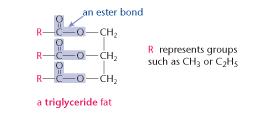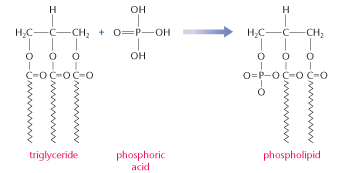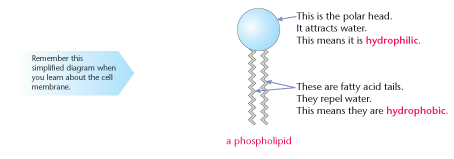Lipids
What are lipids?
These are the oils, fats and waxes. They consist of exactly the same elements as carbohydrates, i.e. carbon (C), hydrogen (H) and oxygen (O) but their proportion is different. There is always a high proportion of carbon and hydrogen, with a small proportion of oxygen. The diagram below shows the structural formula of a typical fat.

Fats and oils are formed when fatty acids react with glycerol. During this reaction water is produced, a further example of a condensation reaction. The essential bond is the ester bond.

Fats and oils can be changed back into the original fatty acids and glycerol. Enzymes (see page 46) are needed for this transformation together with water molecules. An enzyme reaction which requires water to break up a molecule is known as hydrolysis.
What are saturated and unsaturated fats?
The answer lies in the types of fatty acid used to produce them. The hydrocarbon chains are so long that they are often represented by the acid group (–COOH) and a zig-zag line.


Note that when saturated fatty acids react with glycerol they make saturated fats. Conversely, unsaturated fatty acids make unsaturated fats.
Key Point: Saturated fatty acids have no C=C (double bonds) in their hydrocarbon chain, but unsaturated fatty acids do. This is the difference.
How useful are lipids?
Like carbohydrates, they are used as an energy supply, but a given amount of lipid release more energy than the same amount of carbohydrate. Due to their insolubility in water and compact structure, lipids have long-term storage qualities.
Adipose cells beneath our skin contain large quantities of fat which insulate us and help to maintain body temperature. Fat gives mechanical support around our soft organs and even gives electrical insulation around our nerve axons.
An aquatic organism such as a dolphin has a large fat layer which:
- is an energy store
- a thermal insulator
- helps the animal remain buoyant.
The most important role of lipids is their function in cell membranes. To fulfil these functions a triglyceride fat is first converted into a phospholipid.
Never give an ambiguous answer like this; ‘fats keep an animal warm’. The examiner does not
know whether you are referring to energy release by mitochondria or the insulation property. Be specific, otherwise you will not be credited.

Phosphoric acid replaces one of the fatty acids of the triglyceride. The new molecule, the phospholipid, is a major component of cell membranes. The diagram below represents a phospholipid.

